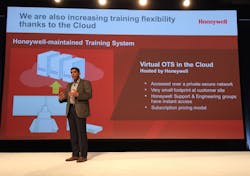Process industries might be fraught with challenges, not least of which these days is the price of oil and its effect on projects, but it’s also bounding with solutions. Adoption of cloud computing is arguably one of the most significant game changers to come along.
It was only a few years ago that talk about cloud computing brought mostly skepticism—suitable for business applications, perhaps, but not something that manufacturing was likely to jump on board with anytime soon. That story has changed. “Cloud is real. If you’re not adopting it quick enough, the speed of adoption will leave you behind,” said Vimal Kapur, president of Honeywell Process Solutions (HPS), providing industry perspective at the Honeywell Users Group (HUG) Americas Symposium this week in San Antonio, Texas.
A lot of the push to the cloud for customers has been done through HPS’s own belief in its feasibility, Kapur mentioned in a separate conversation. “We made the decision that all of our projects would be on the cloud,” he said. “If customers want to join it, they’re welcome to the party. That’s how you change opinion. People start climbing on the wagon. Our own adoption became key to taking technologies to their logical end.”
HPS embraced the cloud for customer projects beginning in 2013, Kapur said, and today has some 9,300 virtual machines on its cloud. As of April 2015, HPS had executed almost 2,200 projects in the cloud environment.
“The cloud is a strong milestone in our ability to do more with less,” Kapur said, with a nod to a key challenge that industry faces today.
Providing an overview of those challenges, Kapur listed fewer resources and the need to do more with those resources as No. 1. Other key challenges include operating safely and staying in compliance, leveraging technology to stay relevant, and addressing the first three challenges with fewer skilled workers.
Cloud computing will be instrumental in addressing much of the challenge. With respect to doing more with less, Kapur pointed to HPS’s ability to perform factory acceptance testing (FAT) over the cloud. “It just takes the project efficiency to a different level,” he said. “We believe it’s going to add a significant level of productivity in how projects are performed.”
HPS has been able to reduce configuration and setup time by up to 60 percent using its cloud tools, according to Kapur. “There’s been a dramatic shift in how we feel about field instrumentation.”
The cloud is also enabling increased training flexibility. Honeywell is providing virtual operator training systems in the cloud with a subscription pricing model. “The number of people who have to be trained is far more than what it was,” Kapur noted. “Simulation availability in the cloud is another opportunity.”
Of course, the cloud isn’t the only answer. And the highlights that Kapur hit aren’t the only challenges either.
With regard to the lower oil prices, industry has seen a drop in the capital spend available and also the operational spend. “Certainly, it’s a challenging time because less project activity means we’ll all have to think differently,” Kapur said. “We cannot be opaque to this fact. We are highly sensitive to this, understanding the business challenges which are in front of us.”
Honeywell is also sensitive to the fact that about half of the plants it serves are more than 30 years old. They’re working with old equipment, and the people who built and ran the systems for so many years are retiring fast. “The plants are not going to go away, and the people are retiring very quickly,” Kapur said. “Technology intervention has to play a key role.”
The increasing threat of cybersecurity, plus increasing environmental regulations, are also having a considerable impact on manufacturing.
Open systems, though embraced with enthusiasm in the early 2000s, present another type of challenge—namely obsolescence. Operating systems become obsolete all too quickly, and that’s something automation suppliers and their customers must deal with.
In fact, the pace of technological change cannot be overstated, Kapur emphasized during a separate talk. “It is dramatic. It’s not more of the same,” he said. “If that is not appreciated…probably it’s going to have implications.”
The pace of change quickened significantly over just the past two years, Kapur said, pointing to how companies like Google and Apple are updating practically every month. This pushes Microsoft to update its operating systems that much faster, which in turn pushes the automation companies to keep up, he said. “So many layers are coming simultaneously.”
About the Author
Aaron Hand
Editor-in-Chief, ProFood World

Leaders relevant to this article:
